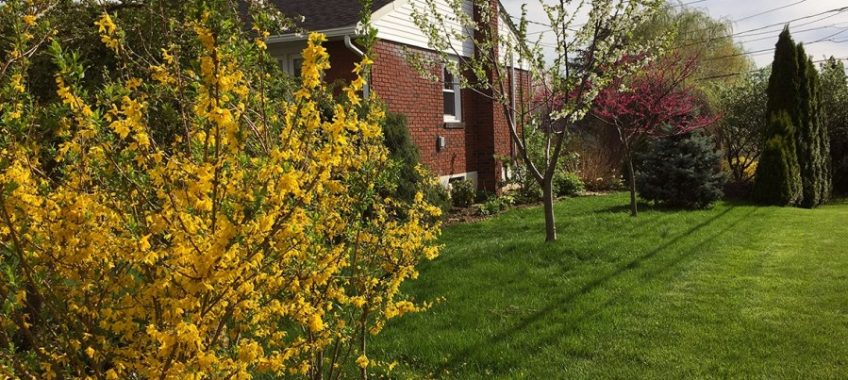30
May
[ad_1]

Climate change is almost too big a subject for us non-scientists to wrap our heads around. Melting ice caps, rising sea levels, record flooding, record drought, record heat – and new records set nearly every year. But climate change is simple to understand when your city, town or home is the subject of a cable news weather disaster headline.
Feeling helpless in the face of Mother Nature, many cannot come to terms with the contribution just 1 person can make to the cause of climate change, much less the solution. So they wait for local and national leaders to make a sweeping, dramatic change to save the planet. But considering that scientists, fossil fuel companies, and the federal government have been well-informed on climate change since the 1970s, don’t count on any of them to ride in on a white horse anytime soon.
But all hope is not lost. Even if you own a small property you can make a contribution to fighting climate change by planting a tree or two or three (or if you don’t have space for trees, woody perennials). Multiply that effort by the millions of property owners in the United States alone, and that will be a great start.
Buy on Amazon: Jobe’s TreeStaKit – Everything Needed to Anchor a Tree.
How trees combat climate change
Trees and woody perennial shrubs are key in controlling the level of CO2 in the atmosphere (carbon dioxide is just one of the chemicals responsible for climate change). All plants take in CO2 and release oxygen (the O in CO2) and the carbon molecule is used for many plant functions. In the case of trees and woody perennials like shrubs, it helps form trunks, stems, and root mass, and is stored as wood for years, decades, or even centuries. This is what’s referred to as “sequestering” CO2.
This carbon storage capacity makes trees one of the best tools to reduce CO2 in the atmosphere. According to data on climate change collected by the United States Government as of 2012, U.S. forests, grasslands, and other natural sources sequestered 762 million metric tons (MMT) of CO2 which offset around 11 percent of total U.S. greenhouse gas (GHG) emissions. Sequestering is also known as “carbon sink” – the ability of natural resources to capture atmospheric carbon.
How many trees have we lost?
Since the first European settlers arrived on the shores of the U.S., forestland has seen a net reduction (more were cut down than replaced) of roughly 257 million acres. To give you an idea of how many acres that is, it’s 3X the amount of land currently managed by the National Park Service: every National Park, National Monument, historic battlefield, trail, seashore, and more combined.
But that’s only half the story. When trees are cut down and burned or used for some other purpose, it releases their stored carbon back into the atmosphere. So not only did the loss of that acreage decrease the ability for the planet to absorb carbon, it also increased the amount of carbon in the atmosphere.
It’s estimated by the United States Mid-Century Strategy for deep decarbonization, that if we are able to expand the acreage of trees and natural grasslands by 40-50 million acres, we could offset 50% of US greenhouse gas emissions by 2050.
Yes, the implications of planting that much land with trees seems overwhelming. But it’s actually doable if those responsible for public policy have the will to do it. One may also add, what other choice do we have? Planting trees doesn’t require massive technology development – it’s a simple solution to an overwhelming problem that can be done with a minimal amount of equipment, or even by 1 person at a time.
Can gardeners reduce climate change?
Which brings us back to the beginning. How can homeowners and gardeners help fight climate change? Planting millions of trees across the country, including in urban landscapes, will obviously take years. In the meantime, the trees that you plant on your property can begin the carbon sink. Trees also contribute to protecting your home from severe weather and shade it in summer, saving on air conditioning costs (which also fights climate change by reducing energy use). Trees also have the added benefit of attracting wildlife like birds which keep down the pest populations in your landscape.
The importance of taking action and planting trees can’t start soon enough. If you have a shaded property, congratulations, you’re part of the solution. But if your property is a clear-cut, golf-green-like lawn from the street to your front door, 1) why? and 2) buy a tree or two or six and plant them today.
Every tree is a good tree, but if you buy native species of trees – that is, trees that have evolved in your region – they will be very low maintenance (if at all) once established and should thrive. Just be sure you make a note of the mature height and spread of the tree and plant them in a location where the mature size won’t crowd your foundation or other trees.
There’s an old adage: the best time to plant a tree was 20 years ago. The 2nd best time to plant a tree is today.
[ad_2]
Source link
